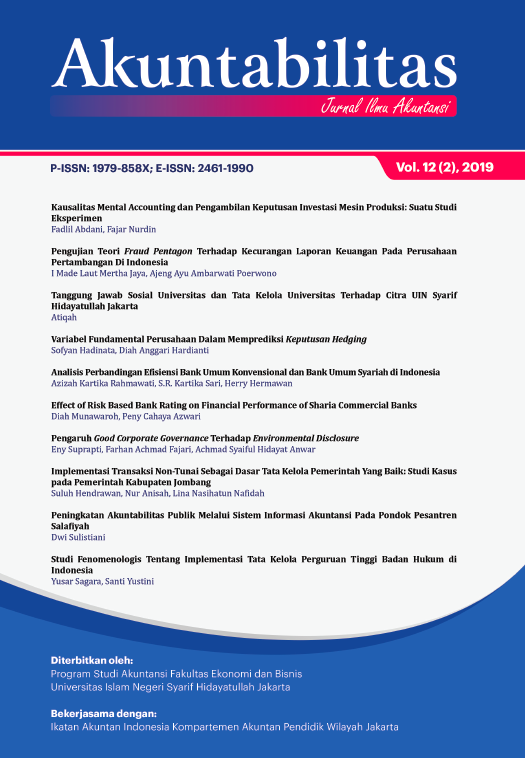PENGUJIAN TEORI FRAUDPENTAGON TERHADAP KECURANGAN LAPORAN KEUANGAN PADA PERUSAHAANPERTAMBANGANDIINDONESIA
DOI:
https://doi.org/10.15408/akt.v12i2.12587Keywords:
fraud pentagon, fraud of financial statementsAbstract
This study wasto determine the effect of financial targets, financial stability, external pressure, ineffective monitoring, the nature of industry, change in auditors, rationalization, change of directors, and CEO's picture of fraudulent financial statements in mining companies in Indonesia. This study uses descriptive quantitative methods. Technique of collecting data through documentation. The data used in this study are secondary data in the form of annual reports or annual reports of mining sector companies listed on the Indonesia Stock Exchange for the period 2013-2017. Next, the data was tested using multiple linear regression methods. The results of the study found that the target Financial and Nature of industry had an effect on fraudulent financial statements. Meanwhile, Financial stability, External pressure, and Ineffective monitoring, Change in auditors, Rationalization, and Change of directors, and CEO's picture, have no effect on fraudulent financial statements in mining companies in Indonesia.
References
Albrecht W. S., & Albrecht C. O. (2002). Fraud Examination. Journal Academic Ethic, 7, 207-221.
Annisya, M., Lindriansari., & Asmaranti, Y. (2016). Pendeteksian Kecurangan Laporan Keuangan Menggunakan Fraud Diamond. Jurnal Bisnis dan Ekonomi, 23(1), 72-89.
Aprilia. (2017). Analisis Pengaruh Fraud Pentagon Terhadap Kecurangan Laporan Keuangan Menggunakan Beneish Model Pada Perusahaan yang Menerapkan ASEAN Corporate Governance Scorecard. Jurnal Akuntansi Riset, 6(1), 96-126.
Bawekes, H. F., Simanjuntak, A. M. A., & Daat, S. C. (2018). Pengujian Fraud Pentagon Terhadap Fraudulent Financial Reporting: Studi Empiris pada Perusahaan yang Terdaftar di BEI Tahun 2011-2015. Jurnal Akuntansi dan Keuangan Daerah, 13(1), 114-134
Beneish, M. D. (1999). The Detection of Earnings Manipulation. Financial Analysis Journal, 55(5), 24-36.
Carlson, S. J., & Bathala, C. T. (1997). Ownership Differences and Firm’s Income Smoothing Behavior. Journal of Business and Accounting, 24(2), 179-196. https://doi.org/10.1111/1468-5957.00101.
Cressey, D. R. (1953). Other People’s Money. Montclair, New Jersey: Patterson Smith.
Crowe, H. (2011). Putting the Freud in Fraud: Why the Fraud Triangle Is No Longer Enough. IN Howart, Crowe
Dalnial, H., Kamaluddin, A., Sanusi, Z. M., & Khairuddin, K. S. (2014). Detecting Fraudulent Financial Reporting through Financial Statement Analysis. Journal of Advanced Management Science, 2(1), 17-22.
Ijudien, D. (2018). Pengaruh Stabilitas Keuangan, Kondisi Industri, dan Tekanan Eksternal Terhadap Kecurangan Laporan Keuangan. Jurnal Kajian Akuntansi, 2(1), 82-97.
Schipper, K. (1989). Comentary Katherine on Earnings Management. Accounting Horizon, 3, 91-102.
Setiawati, E., & Baningrum, R. M. (2018). Deteksi Fraudulent Financial Reporting Menggunakan Analisis Fraud Pentagon: Studi Kasus Pada Perusahaan Manufaktur yang Listed di BEI Tahun 2014-2016. Riset Akuntansi dan Keuangan Indonesia, 3(2), 91-106.
Sihombing, K. S., & Rahardjo, S. N. (2014). Analisis Fraud Diamond dalam Mendeteksi Financial Statement Fraud: Studi Empiris pada Perusahaan Manufaktur yang Terdaftar di Bursa Efek Indonesia (BEI) Tahun 2010-2012. Diponegoro Journal of Accounting, 3(2), 1-12.
Skousen, C. J., Smith K. R., & Wright, C. J. (2009). Detecting and Predicting Financial Statement Fraud: The Effectiveness of the Fraud Triangle and SAS No. 99. Corporate Governance and Firm Performance Advance in Financial Economics, 13, 53-81.
Stice, J. D. (1991). Using Financial and Market Information to Identify Preengagements Factors Associated with Lawsuits Against Auditors. The Accounting Review, 66(3), 516-533.
St. Pierre, K., & Anderson, J. A. (1984). An Analysis of The Factors Associated With Lawsuits Against Public Accountants. The Accounting Review, 59(2), 242-263.
Subramanyam, K. R., & Wild, J. J. (2010). Analisis Laporan Keuangan, Edisi Sepuluh. Jakarta: Salemba Empat.
Summers, S. L., & Sweeney, J. T. (1998). Fraudulently Misstated Financial Statements and Insider Trading: an Empirical Analysis. The Accounting Review, 73(1), 131-146.
Tessa, G. C., & Harto, P. (2016). Fraudulent Financial Reporting: Pengujian Teori Fraud Pentagon pada sektor Keuangan dan Perbankan di Indonesia. Proceeding Simposium Nasional Akuntansi XIX Lampung, 1-21.
Tuanakotta, T. M. (2013). Mendeteksi Manipulasi Laporan Keuangan. Jakarta: Salemba Empat.
Widyastuti, T. (2009). Pengaruh Struktur Kepemilikan dan Kinerja Keuangan Terhadap Manajemen Laba: Studi pada Perusahaan Manufaktur di BEI. Jurnal MAKSI, 9(1), 30-41.
Wolfe, D. T., & Hermanson, D. R. (2004). The Fraud Diamond: Considering the Four Elements of Fraud. CPA Journal, 74(12), 38-45.
Yesiariani, M., & Rahayu, I. (2017). Deteksi Financial Statement Fraud: Pengujian Fraud Diamond. Jurnal Akuntansi & Auditing Indonesia, 21(1), 49-60. https://doi.org/10.20885/jaai.vol21.iss1.art5.

